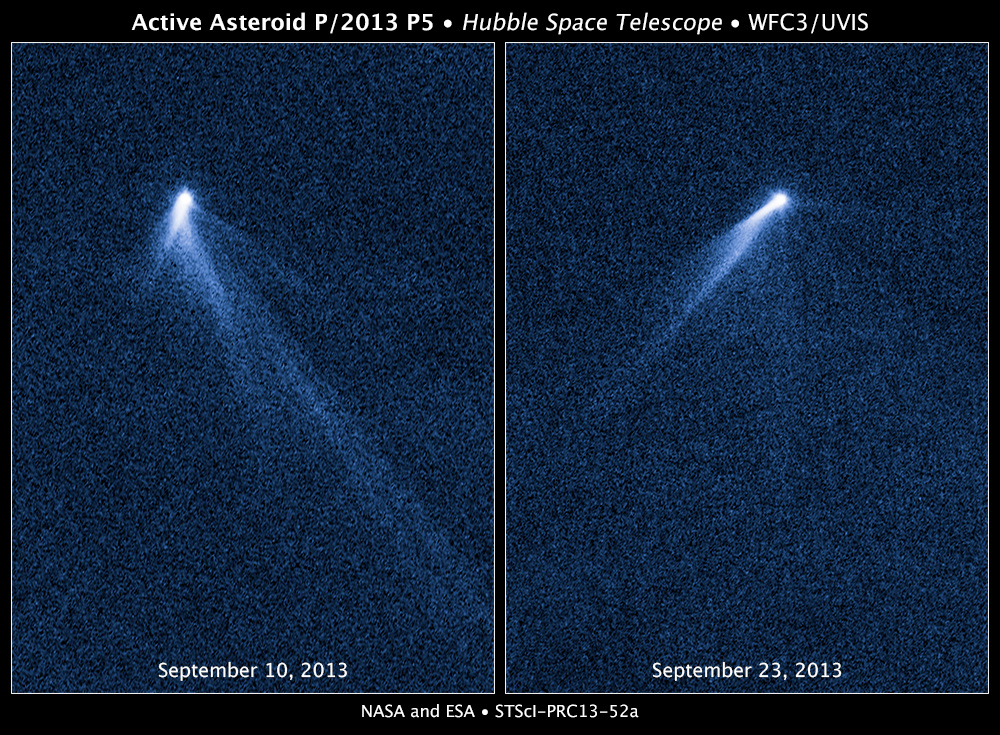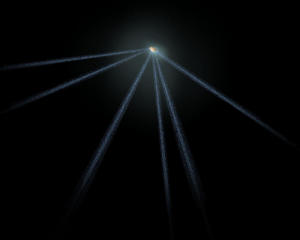It looks like you're using an Ad Blocker.
Please white-list or disable AboveTopSecret.com in your ad-blocking tool.
Thank you.
Some features of ATS will be disabled while you continue to use an ad-blocker.
share:
I just found this interesting and considering the ATS interest in asteroids and comets I'd thought I'd share.
No, it is not hurtling towards Earth, so no doom porn here. Just an odd object.
phys.org...
No, it is not hurtling towards Earth, so no doom porn here. Just an odd object.
(Phys.org) —Astronomers using NASA's Hubble Space Telescope have identified what they can only describe as a never-before-seen "weird and freakish object" in the asteroid belt that looks like a rotating lawn sprinkler.
Normal asteroids should appear simply as tiny points of light. But this asteroid, designated P/2013 P5, has six comet-like tails of dust radiating from it like spokes on a wheel.
Because nothing like this has ever been seen before, astronomers are scratching their heads to find an adequate explanation for its out-of-this-world appearance.
phys.org...
Awesome find, those pictures look nuts.
Would love to know exactly what's going on with that thing.
Astronomers must be giddy as all be right now.
Would love to know exactly what's going on with that thing.
Astronomers must be giddy as all be right now.
reply to post by Chamberf=6
Very interesting find Chamberf=6. Is it responding to gravitational pulls from different directions possibly, also how much material can be emitted continuously? Will be interesting to see how long this can go on or if it stops.
NAMASTE*******
Very interesting find Chamberf=6. Is it responding to gravitational pulls from different directions possibly, also how much material can be emitted continuously? Will be interesting to see how long this can go on or if it stops.
NAMASTE*******
reply to post by Chamberf=6
Whoa...that is pretty cool. Would love to hear what they are saying about it. Hopefully they will study it a bit more and put out some info on it. Very cool...
Whoa...that is pretty cool. Would love to hear what they are saying about it. Hopefully they will study it a bit more and put out some info on it. Very cool...
reply to post by Ophiuchus 13
Not sure about too much but they do say:
Not sure about too much but they do say:
The asteroid could possibly have been spun up if the pressure of sunlight exerted a torque on the body. If the asteroid's spin rate became fast enough, Jewitt said, the asteroid's weak gravity would no longer be able to hold it together. Dust might avalanche downslope towards the equator, and maybe shatter and fall off, eventually drifting into space to make a tail. So far, only a small fraction of the main mass, perhaps 100 to 1,000 tons of dust, has been lost. The 700-foot-radius nucleus is thousands of times more massive. Read more at: phys.org...
reply to post by Chamberf=6
I love stuff like this, thanks for posting! The pics in the article are great!
I love stuff like this, thanks for posting! The pics in the article are great!
Very interesting information. I like it when people admit that what they are seeing is something that they do not yet understand instead of applying
a bunch of misapplied evidence to it and making up a story. I have heard way too many flawed stories from people who are supposedly professionals in
my life. I actually have liked some of the articles coming out of science the last couple of years. They have real evidence to back them instead of
dribble coming out of someone with a big ego. We have developed some amazing technology to see what is happening instead of assuming that something
is real and backing it with evidence that doesn't apply.
I may get down on science sometimes, but it is constructive criticism aimed at a diverse range of sciences to try to do broadform scientific research instead of narrow minded research.
I may get down on science sometimes, but it is constructive criticism aimed at a diverse range of sciences to try to do broadform scientific research instead of narrow minded research.
These new finds are so exciting.
“Somewhere, something incredible is waiting to be known.”
Carl Sagan
Astronomers must be giddy as all be right now.
LOL. I believe sick to the stomach is a better bet. That's the feeling you get when a "standard" scientific model breaks.
I believe electric plasma discharge is the leading hypothesis for these "streamers" that magically hold together for impossibly long distances. These features rotate with the body? Hm dust jets can't do that under the influence of gravity alone. Solar wind? That's some really complex wind.
Maybe someone will get the bright idea to observe for x-rays. It would indeed be odd to see x-rays coming from an asteroid wouldn't it?
A rapid rotation sounds reasonable. It could also be some hidden deposits of ice that somehow got exposed to the vacuum and sun's heat. That
could've happened due to gravitational tug from other bodies in the Solar System, an impact, or even the Sun's activity.
Regardless, it will be interesting to learn the chemical makeup of the expelled material though spectroscopy.
Electric Universe crowd will jump on this as the evidence of plasma discharges, but why would an asteroid that existed where it is for millions or even billions of years show this activity? It's electric charge should have long been stabilised.
Regardless, it will be interesting to learn the chemical makeup of the expelled material though spectroscopy.
Electric Universe crowd will jump on this as the evidence of plasma discharges, but why would an asteroid that existed where it is for millions or even billions of years show this activity? It's electric charge should have long been stabilised.
Plot Twist, it turns out it's an alien spacecraft from one of those billions of earth-like planets in our solar system.
From what I've looked up about alien stuff, might be a space ship that looks like an asteroid.
tokejesus
Plot Twist, it turns out it's an alien spacecraft from one of those billions of earth-like planets in our solar system.
Billions in our solar system, eh?
New to me.
wildespace
A rapid rotation sounds reasonable. It could also be some hidden deposits of ice that somehow got exposed to the vacuum and sun's heat. That could've happened due to gravitational tug from other bodies in the Solar System, an impact, or even the Sun's activity.
Regardless, it will be interesting to learn the chemical makeup of the expelled material though spectroscopy.
Electric Universe crowd will jump on this as the evidence of plasma discharges, but why would an asteroid that existed where it is for millions or even billions of years show this activity? It's electric charge should have long been stabilised.
Maybe the asteroid is reacting to an approaching electrically charged object. This isnt an isolated case. They are calling these newelly illuminated objects " Lazarus comets".
All of our recent geomagnetic disturbances point to an approaching celestial object. If it isnt illuminated in the visible light spectrum, it wouldnt be easy to detect. The EU theory would make this plausable. Gravity isnt the only force at play.
Prophecy supports this possibility as well. Read the sixth seal in Revelation.
InverseLookingGlass
LOL. I believe sick to the stomach is a better bet. That's the feeling you get when a "standard" scientific model breaks.
LOL back to you.
Nobel prizes are what you get when you break a standard model.
Scientists love to discover new things.
new topics
-
Simple Thanksgiving
Food and Cooking: 3 hours ago -
Trump could make a peaceful American Revolution
US Political Madness: 7 hours ago -
Trump Presidential Transition Team will not use GSA or Government entities to come to DC
US Political Madness: 7 hours ago -
Mind Blowing Cave under someones land
Fragile Earth: 7 hours ago -
The Party of Peace - Trump Cabinet Picks Targeted with Death Threats
US Political Madness: 8 hours ago -
V.P. Kamala Harris releases a video and nobody understands why
US Political Madness: 11 hours ago
top topics
-
D.B. Cooper mystery may be solved
General Conspiracies: 16 hours ago, 21 flags -
V.P. Kamala Harris releases a video and nobody understands why
US Political Madness: 11 hours ago, 16 flags -
The Party of Peace - Trump Cabinet Picks Targeted with Death Threats
US Political Madness: 8 hours ago, 14 flags -
Trump Presidential Transition Team will not use GSA or Government entities to come to DC
US Political Madness: 7 hours ago, 13 flags -
Trump could make a peaceful American Revolution
US Political Madness: 7 hours ago, 13 flags -
Mind Blowing Cave under someones land
Fragile Earth: 7 hours ago, 12 flags -
Simple Thanksgiving
Food and Cooking: 3 hours ago, 5 flags
active topics
-
V.P. Kamala Harris releases a video and nobody understands why
US Political Madness • 73 • : chr0naut -
Post A Funny (T&C Friendly) Pic Part IV: The LOL awakens!
General Chit Chat • 7839 • : argentus -
Trump Presidential Transition Team will not use GSA or Government entities to come to DC
US Political Madness • 10 • : marg6043 -
Simple Thanksgiving
Food and Cooking • 16 • : argentus -
President-Elect DONALD TRUMP's 2nd-Term Administration Takes Shape.
Political Ideology • 255 • : NoCorruptionAllowed -
The Party of Peace - Trump Cabinet Picks Targeted with Death Threats
US Political Madness • 13 • : marg6043 -
I thought Trump was the existential threat?
World War Three • 109 • : network dude -
Federal law trumps state and local law every time
Social Issues and Civil Unrest • 33 • : yuppa -
The Acronym Game .. Pt.4
General Chit Chat • 995 • : JJproductions -
Trump could make a peaceful American Revolution
US Political Madness • 8 • : Flyingclaydisk


